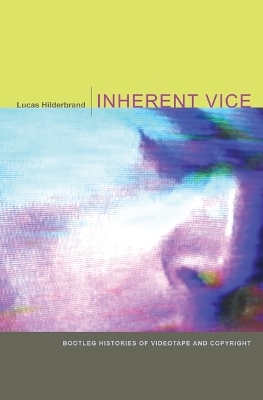
Inherent Vice
Duke University Press (Verlag)
978-0-8223-4353-0 (ISBN)
- Titel z.Zt. nicht lieferbar
- Versandkostenfrei innerhalb Deutschlands
- Auch auf Rechnung
- Verfügbarkeit in der Filiale vor Ort prüfen
- Artikel merken
In an age of digital technology and renewed anxiety about media piracy, Inherent Vice revisits the recent analog past with an eye-opening exploration of the aesthetic and legal innovations of home video. Analog videotape was introduced to consumers as a blank format, essentially as a bootleg technology, for recording television without permission. The studios initially resisted VCRs and began legal action to oppose their marketing. In turn, U.S. courts controversially reinterpreted copyright law to protect users’ right to record, while content owners eventually developed ways to exploit the video market. Lucas Hilderbrand shows how videotape and fair use offer essential lessons relevant to contemporary progressive media policy. Videotape not only radically changed how audiences accessed the content they wanted and loved but also altered how they watched it. Hilderbrand develops an aesthetic theory of analog video, an “aesthetics of access” most boldly embodied by bootleg videos. He contends that the medium specificity of videotape becomes most apparent through repeated duplication, wear, and technical failure; video’s visible and audible degeneration signals its uses for legal transgressions and illicit pleasures. Bringing formal and cultural analysis into dialogue with industrial history and case law, Hilderbrand examines four decades of often overlooked histories of video recording, including the first network news archive, the underground circulation of Superstar: The Karen Carpenter Story, a feminist tape-sharing network, and the phenomenally popular website YouTube. This book reveals the creative uses of videotape that have made essential content more accessible and expanded our understanding of copyright law. It is a politically provocative, unabashedly nostalgic ode to analog.
List of illustrations ix
Preface ix
Acknowledgments xxi
Part I. Videotape and Copyright
Introduction: The Aesthetics of Access 1
Video Clip: Diasporic Asian Video Markets in Orange County 27
1. Be Kind, Rewind: The Histories and Erotics of Home Video 33
Video Clip: Chiller Theatre Toy, Model, and Film Expo 73
2. The Fairest of Them All? Home Video, Copyright, and Fair Use 77
Part II. Case Studies
3. The Revolution Was Recorded: Vanderbilt Television News Archive, Copyright in Conflict, and the Making of TV History 115
Video Clip: Experimental Film on Video: A Frameworks Debate 157
4. Grainy Days and Mondays: Superstar and Bootleg Aesthetics 161
Video Clip: Tape Art 191
5. Joanie and Jackie and Everyone They Know: Video Chainletters as Feminist Community Network 195
Epilogue: YouTube: Where Cultural Memory and Copyright Converge 225
Timeline 245
Notes 251
Bibliography 287
Index 311
| Zusatzinfo | 54 illustrations |
|---|---|
| Verlagsort | North Carolina |
| Sprache | englisch |
| Gewicht | 649 g |
| Themenwelt | Kunst / Musik / Theater ► Fotokunst |
| Geschichte ► Teilgebiete der Geschichte ► Kulturgeschichte | |
| Recht / Steuern ► EU / Internationales Recht | |
| Sozialwissenschaften ► Kommunikation / Medien ► Medienwissenschaft | |
| ISBN-10 | 0-8223-4353-3 / 0822343533 |
| ISBN-13 | 978-0-8223-4353-0 / 9780822343530 |
| Zustand | Neuware |
| Haben Sie eine Frage zum Produkt? |
aus dem Bereich


